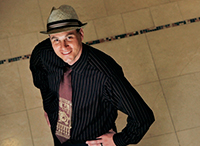
With nearly half a million residents of Arab descent, Metro Detroit has the second largest share of Arab American residents in the country. And fittingly, Dearborn is home to the nation's first museum devoted to this population's rich history and culture. This week Devon Akmon, deputy director of the Arab American National Museum, blogs about building community through multicultural programming.
Post 1: Arab American National Museum is 1 in 17,000
Posted By: Devon Akmon
Posted: 4/22/2010
Founded on May 5, 2005, the Arab American National Museum (AANM) will soon celebrate its fifth anniversary. People are often curious about the Museum's origins and its location. Although the Museum is still very much a startup, its roots extend back to the late 1980s. In fact, the AANM is a part of the Dearborn-based Arab Community Center for Economic and Social Services (ACCESS). In 1987 the agency developed a cultural arts department to educate the public on Arab American culture and to provide affordable and accessible arts programming. Today, the AANM is an extension of this program and it remains a vibrant department within ACCESS. Although it is very uncommon for a museum to be part of a social service agency, ACCESS considers the arts to be just one part of a multi-component approach to providing comprehensive services for living an enriched and fulfilling life.
Southeast Michigan is home to the largest concentration of Arab Americans in the United States. An estimated 500,000 Arab Americans reside in Michigan and approximately one-third of Dearborn's population is of Arab ancestry. This makes Dearborn the logical place for a community-based museum with a focus on Arab Americans. Thanks to the numerous ethnic businesses in the area, guests can learn about the history within the museum and explore the surrounding community to experience firsthand the food and culture. This provides a truly immersive experience.
There are over 17,000 museums in the United States, and the AANM is the only one dedicated to documenting and celebrating Arab American history and culture. Similar to other ethnic museums, the AANM serves as an outlet for an underrepresented community. In fact, prior to its origin, the only major museum collection of Arab American history was the Alixa Naff collection at the Smithsonian Institution in Washington, D.C. Today, the AANM is an Affiliate of the Smithsonian and it houses its own permanent collection, which includes oral histories, photographs, artwork and personal artifacts and ephemera. In addition to being a source of community pride, the AANM serves as a catalyst for building collective community history.
Historically, wealthy individuals who amassed large personal collections founded many museums in the United States. Other museums were founded to preserve and display a particular type of object or collection. The AANM focuses more on community than objects. In fact, a key interpretive strategy is to tell community history through the use of personal stories. The artifacts on display help to interpret and provide meaning to the stories. These stories create a mosaic that collectively provides insight into the history of Arab Americans and their traditions. Moreover, it is a way to develop empathy, dispel stereotypes, and celebrate the commonalities between all Americans.
At its core, the AANM is a community-based museum representing a community nationwide. The stories and objects on display come from around the country and span hundreds of years of history within the United States. As part of the planning process when building the AANM, staff traveled the country conducting focus groups in Arab American communities and collecting stories and artifacts. This work served as the foundation for the museum and its collection.
As a way to remain rooted in the community, the AANM utilizes many committees comprised of community members with a particular level of expertise. These committees include a National Advisory Board comprised of prominent Arab Americans; a Friends Committee who work tirelessly to raise funds for the museum; collections and exhibits committees that work with the curatorial team; and special committees formed to assist with key programs at the museum. This allows an exchange of ideas, a process for receiving feedback and a way to explore ideas and meet the needs of the Arab American community.